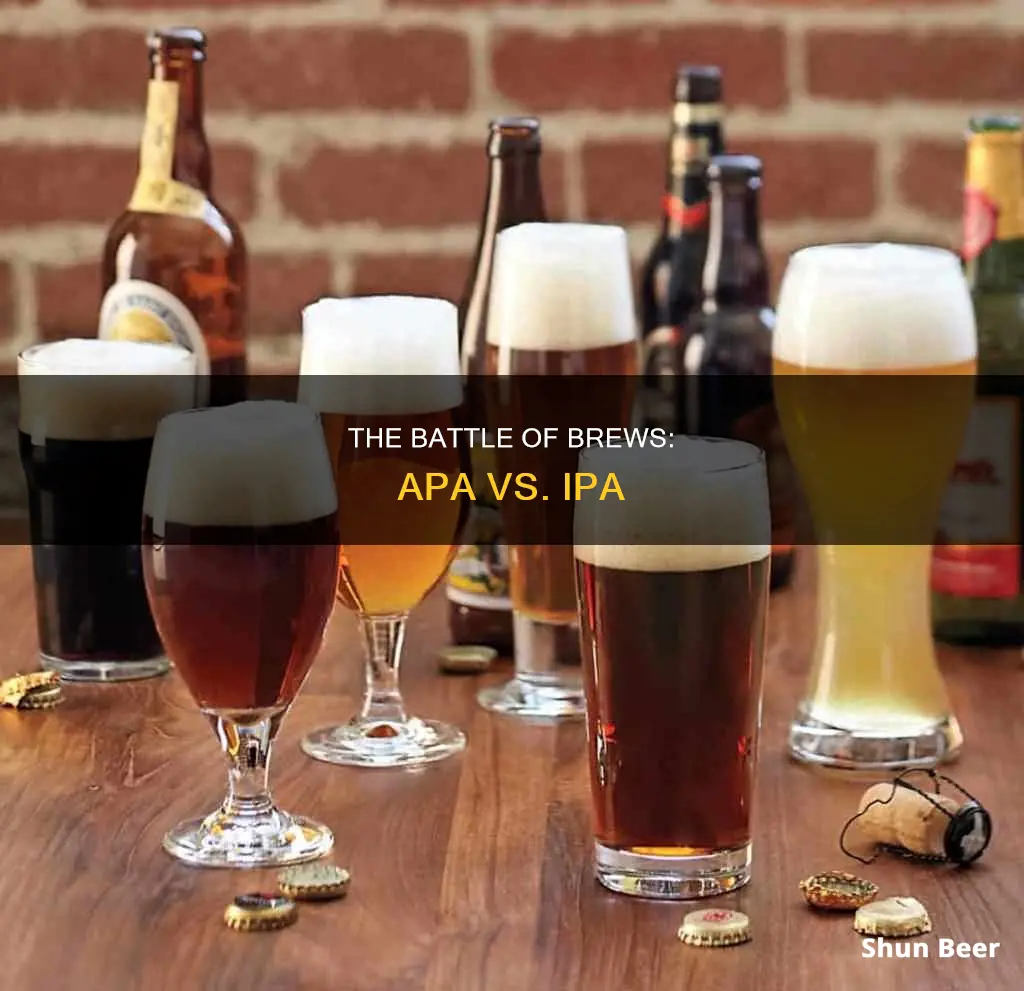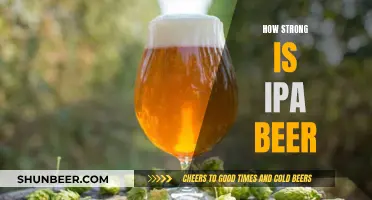
The difference between APA and IPA beers is a complex and fascinating topic. APA stands for American Pale Ale, while IPA stands for India Pale Ale. Both have their roots in British island styles, but APAs are brewed in the United States and use American hops, which are more pungent and floral. IPAs were originally created in the 1800s for British soldiers in India, with extra hops added as a preservative during the long journey. APA and IPA beers differ in terms of bitterness, alcohol content, and flavour. IPAs are typically more bitter due to their higher hop content, while APAs are more balanced. APAs have a modest caramel taste and a malt and hop balance, while IPAs provide a tangy and succulent flavour experience. The average alcohol percentage of an APA is around 5%, while an IPA is usually around 6%.

History of IPAs and APAs
The history of IPAs and APAs is a long and complex one, spanning centuries and involving many different countries.
IPAs
India Pale Ale (IPA) was originally an export beer shipped to India, which was under the control of the British East India Company until 1858. The beer was created in the 18th century to withstand the long journey by sea from Britain to India, as ordinary beer would often spoil and go flat during the voyage. Brewers found that adding extra hops to the beer helped to preserve it, creating a bitter and stronger pale ale that was more refreshing in the hot Indian climate.
The popular origin story of IPA involves George Hodgson, a brewer at the Bow Brewery in East London, who began sending his pale ale to India in the late 18th century. However, while Hodgson may have been the first brewer to achieve widespread distribution in India, he was not the only one experimenting with brewing techniques to create a beer that could survive the journey.
By the early 19th century, "pale ale prepared for the India market" was gaining in popularity, and by the 1830s, India Pale Ale had become one of England's best-selling beers. The style eventually fell out of favour in England, but was revived in the United States during the craft beer revolution of the 1970s and 80s. American brewers began creating their own versions of IPAs, experimenting with new hop varieties and increasing the alcohol content. Today, IPAs come in a wide range of styles, including West Coast, East Coast, New England, and Belgian, among others.
APAs
American Pale Ale (APA) is a style of pale ale that was developed in the United States around 1980. It is similar to IPA but with a more balanced flavour profile, blending malts and hops with a lighter character and a citrusy punch. The key distinction between APA and IPA is the use of American hops, which give APAs a more pungent and floral character compared to their British counterparts.
The first brewery to successfully commercialise the use of significant quantities of American hops in APA was the Sierra Nevada Brewing Company, which brewed the first batch of Sierra Nevada Pale Ale in 1980. Anchor Liberty Ale, brewed by Anchor Brewing Company, is also considered a landmark beer in the development of APA.
Today, the lines between APA and IPA continue to blur, as brewers experiment with different styles and techniques. However, APA remains a distinct style, known for its balance of malt and hops, with a focus on the unique characteristics of American hops.
The Harp: Guinness Beer's Musical Instrument Trademark
You may want to see also

Alcohol content
The alcohol content of beer is measured by its ABV (alcohol by volume). The average ABV of an IPA is 6%, though some sub-styles may be lower (e.g. Session IPAs) or higher (e.g. Imperial IPAs). Some IPAs may have alcohol levels as high as 20%, and some as low as 0%.
The average ABV of an APA is 5%, with a range of 4.5% to 6.2%.
The higher ABV of IPAs is due to the fact that they are brewed with higher specific gravities. The higher alcohol content also acts as a preservative, allowing the beer to survive long voyages.
Session IPAs are designed to be lower in ABV than the average IPA, so that they can be consumed in higher quantities during a drinking session.
Double IPAs (or Imperial IPAs) are a stronger, very hoppy variant of IPAs, with alcohol content typically above 7% by volume. The term "double" refers to the increased amount of ingredients used, particularly hops, which results in a beer that is both higher in alcohol and richer in hop character compared to a standard IPA.
Triple IPAs are characterised by higher hop flavours and higher alcohol content, with alcohol content usually over 10% ABV.
Guinness Beer and Keto: Is It a Match?
You may want to see also

Taste and flavour
The main difference between an American Pale Ale (APA) and an India Pale Ale (IPA) is in their hops and alcohol content. IPAs are hop-and-alcohol-heavy, while APAs have a balance of malts and hops, with a lighter character and a citrusy punch.
APA
APAs are characterised by their use of American hops, such as Cascade and Chinook, which give off citrusy flavours. The body of an APA is medium-light with a clean finish that quenches your thirst. The colour is usually golden to copper-coloured, with an ABV between 4% and 6%. APAs are highly hopped, meaning they have a higher level of bitterness and aroma than other alcoholic beverages. The fermentation process is similar to most ale beers, with the wort fermented for about 10 days with a specific strain of yeast.
IPA
IPAs, on the other hand, are known for their strong character, decent alcohol content, and clean yeast profile that showcases the local hops. They are often described as bitter, with an increased amount of hops that can add evident, bracing, and even aggressive bitterness. However, not all IPAs are bitter. The modern approach to hoppy beer explores the world of fruity flavours that can also come from hops. IPAs have lots of flavour, and drinkers experience a mix of stimuli that create a synthetic sense of flavour. While taste buds can identify sweet, bitter, sour, salty, or umami flavours, the flavour of an IPA is created by pairing the taste with the aroma and golden colour, resulting in flavours like grapefruit, pine, and roses.
Comparison
The difference between British and American IPAs is much clearer than the difference between APA and American-style IPA. An APA maintains a balance between malt and hops, with the hops being more assertively pungent and floral than their British counterparts. As APAs become hoppier and higher in alcohol content, they start to resemble American-style IPAs, where the malt takes a back seat to the hops. A British-style IPA is maltier, sometimes buttery, with fruity esters and a hop character that delivers herbal and blackcurrant notes. In contrast, an American-style IPA has a cleaner, leaner malt base and uses native hops to create a bolder drinking experience.
Guinness Blonde: A Dark Beer or Light Lager?
You may want to see also

Ingredients
The main ingredients in beer are yeast, malt, and hops. However, the differences in ingredients between IPAs and APAs are what set them apart.
APA Ingredients
APAs, or American Pale Ales, are characterised by their use of American hops, which are more pungent and floral than British hops. They also have a higher alcohol content than typical English ales, with an ABV ranging from 4.5 to 6.2%, and an average of 5%. The malt content in APAs must balance the modest hop bitterness, resulting in a clarity that ranges from hazy to clear. The hop flavours can be citrusy, piney, or peppery, and the aromas range from mild to intense, with fruity aromas being less common. The mouthfeel of an APA should be smooth, with a light to medium body.
IPA Ingredients
IPAs, or India Pale Ales, are known for their high hop content, which makes them more bitter. They contain a higher-than-average alcohol content, typically around 6% ABV, but some sub-styles may be lower or higher. The ingredients in IPAs can include water, yeast, traditional hops, fruit juices, spices, pale malts, and citrus. The hop aromas in IPAs are generally intense with strong citrus-like and floral notes. The bitterness of IPAs can range from mild to very prevalent, and they often have a harsher hops flavour that is balanced by strong notes of citrus and earthy or floral tones.
APA vs IPA Ingredients
While both APAs and IPAs are members of the ale family, the key difference in ingredients lies in the type of hops used. APAs use American hops, while IPAs traditionally use British hops, resulting in different flavour profiles. Additionally, IPAs tend to have a higher alcohol content and a more bitter taste due to the increased hop content.
Guinness Beer's Dark Appearance: A Black Mystery Solved
You may want to see also

Brewing process
Brewing an APA or an IPA involves a number of steps, from preparing the ingredients to fermentation and bottling. Here is a detailed guide to the brewing process for both types of beer.
APAs (American Pale Ales) are highly hopped, with a higher level of bitterness and aroma than other alcoholic beverages. The colour is typically golden to copper, with an ABV between 4% and 6%. The brewing process for an APA involves the following steps:
- Preparing the Ingredients: The malt for an APA is usually a blend of two-row and six-row barley, while the hops can vary depending on the batch. American hops such as Cascade and Chinook are commonly used, giving the beer its unique flavour.
- Mashing: The mash temperature should be maintained at around 149°F (65°C) for optimal results. The malts are added to the mash, and once the desired temperature is reached, the hops are added.
- Boiling: This is when the mixture of malt and hops is boiled. Hops are typically added at different times during the boil to achieve the desired flavour and bitterness.
- Fermentation: The fermentation process for an APA is similar to most ale beers. The wort is fermented for about 10 days with a specific strain of yeast.
- Bottling or Kegging: Once fermentation is complete, the beer is ready to be bottled or kegged.
IPAs (India Pale Ales) are known for their strong hoppy character and higher alcohol content. The brewing process for an IPA involves similar steps as the APA, but with some variations:
- Preparing the Ingredients: IPAs traditionally use English hops, which contribute to the distinctive flavour profile.
- Mashing: The mash temperature may vary depending on the desired IPA style. For a drier and less sweet IPA, a lower mash temperature is used, while a higher temperature produces a fuller-bodied beer.
- Boiling: The boiling process for an IPA may be longer to extract more bitterness from the hops. Additionally, a higher volume of hops is used to achieve the signature bitter taste of an IPA.
- Fermentation: The fermentation process for an IPA may be longer, and the type of yeast used can vary depending on the desired style.
- Bottling or Kegging: IPAs are often bottled or kegged and then stored for conditioning. Some IPAs may undergo a secondary fermentation in the bottle or keg, which can enhance the flavour and carbonation.
In summary, the brewing process for both APA and IPA involves similar steps, but the choice of ingredients, temperatures, and techniques vary to create distinct flavours and characteristics in the final product.
Guinness Nitro Beers: Nitrogen-Infused Smoothness or Marketing Hype?
You may want to see also
Frequently asked questions
IPA stands for India Pale Ale. They are characterised by their high hop content, which makes them more bitter, and higher alcohol content.
APA stands for American Pale Ale. They are lighter than typical English ales and are golden in colour. They have fewer malts than IPAs but enough hops to have a moreish flavour.
IPAs are stronger and more bitter than APAs. APAs have a balance of malts and hops, with a lighter character and a citrusy punch.
In the 1700s, British Pale Ale was not surviving the long voyage to India due to the warmer climate. To resolve this, English brewers increased the alcohol content and added hops to the barrels for preservation. This new beer was pale yellow, higher in alcohol content, and delectably bitter.
APA was inspired by British pale ale but uses different hops, which give it a more piney and fruity flavour.







